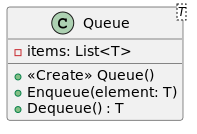This article includes a list of general references, but it lacks sufficient corresponding inline citations .(January 2014) |
| Queue | ||||||||||||||||||||||||
|---|---|---|---|---|---|---|---|---|---|---|---|---|---|---|---|---|---|---|---|---|---|---|---|---|
 Representation of a FIFO (first in, first out) queue | ||||||||||||||||||||||||
| ||||||||||||||||||||||||
In computer science, a queue is an abstract data type that serves as an ordered collection of entities. By convention, the end of the queue where elements are added, is called the back, tail, or rear of the queue. The end of the queue where elements are removed is called the head or front of the queue. The name queue is an analogy to the words used to describe people in line to wait for goods or services. It supports two main operations.
Contents
- Queue implementation
- Queues and programming languages
- Example
- Purely functional implementation
- Amortized queue
- Real-time queue
- See also
- References
- General references
- Further reading
- External links
- Enqueue, which adds one element to the rear of the queue
- Dequeue, which removes one element from the front of the queue.
Other operations may also be allowed, often including a peek or front operation that returns the value of the next element to be dequeued without dequeuing it.
The operations of a queue make it a first-in-first-out (FIFO) data structure as the first element added to the queue is the first one removed. This is equivalent to the requirement that once a new element is added, all elements that were added before have to be removed before the new element can be removed. A queue is an example of a linear data structure, or more abstractly a sequential collection. Queues are common in computer programs, where they are implemented as data structures coupled with access routines, as an abstract data structure or in object-oriented languages as classes. A queue may be implemented as circular buffers and linked lists, or by using both the stack pointer and the base pointer.
Queues provide services in computer science, transport, and operations research where various entities such as data, objects, persons, or events are stored and held to be processed later. In these contexts, the queue performs the function of a buffer. Another usage of queues is in the implementation of breadth-first search.




























